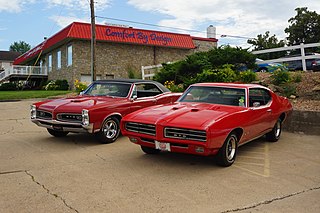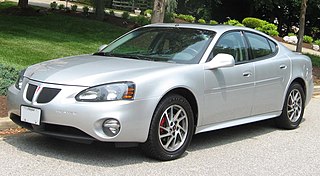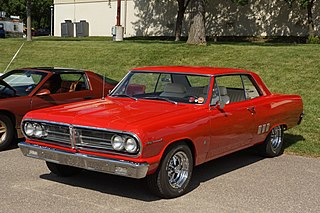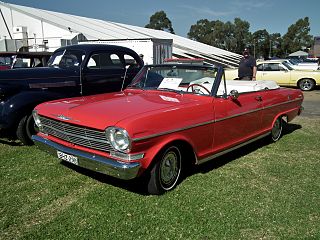
Pontiac or formally the Pontiac Motor Division of General Motors, was an American automobile brand owned, manufactured, and commercialized by General Motors. Introduced as a companion make for GM's more expensive line of Oakland automobiles, Pontiac overtook Oakland in popularity and supplanted its parent brand entirely by 1933.

The Pontiac GTO is an automobile that was manufactured by American automaker Pontiac from 1963 to 1974 for the 1964 to 1974 model years, and by GM's subsidiary Holden in Australia for the 2004 to 2006 model years.

The Chevrolet Chevelle is a mid-sized automobile that was produced by Chevrolet in three generations for the 1964 through 1978 model years. Part of the General Motors (GM) A-body platform, the Chevelle was one of Chevrolet's most successful nameplates. Body styles included coupes, sedans, convertibles, and station wagons. The "Super Sport" versions were produced through the 1973 model year, and Lagunas from 1973 through 1976.

The Buick Skylark is a passenger car formerly produced by Buick. The model was made in six production runs, during 46 years, over which the car's design varied dramatically due to changing technology, tastes, and new standards implemented over the years. It was named for the species of bird called skylark.

The Chevrolet Bel Air is a full-size car produced by Chevrolet for the 1950–1975 model years. Initially, only the two-door hardtops in the Chevrolet model range were designated with the Bel Air name from 1950 to 1952. With the 1953 model year, the Bel Air name was changed from a designation for a unique body shape to a premium level of trim applied across a number of body styles. The Bel Air continued with various other trim level designations, and it went from a mid-level trim car to a budget fleet sedan when U.S. production ceased in 1975. Production continued in Canada, for its home market only, through the 1981 model year.

The Oldsmobile Cutlass was a series of automobiles produced by General Motors' Oldsmobile division between 1961 and 1999. At its introduction, the Cutlass was Oldsmobile's entry-level model; it began as a unibody compact car, but saw its greatest success as a body-on-frame intermediate. The Cutlass was named after the type of sword, which was common during the Age of Sail.

The Grand Prix is a line of automobiles produced by the Pontiac Division of General Motors from 1962 until 2002 for coupes and 1989–2008 for sedans.

The Pontiac Catalina is a full-size, junior series automobile produced by Pontiac from 1950 to 1981. Initially, the name was a trim line on hardtop body styles, first appearing in the 1950 Chieftain Eight and DeLuxe Eight lines. In 1959, it became a separate model as the "entry-level" full-size Pontiac.

The Pontiac Bonneville is an automobile built by Pontiac from 1957 until 2005. Bonnevilles were full-sized, with the exception of a brief period of mid-size between 1982 and 1986. The brand was introduced as a limited production performance convertible during the 1957 model year. The Bonneville, and its platform partner, the Grand Ville, are some of the largest Pontiacs ever built; in station wagon body styles they reached just over 230 inches (5.8 m) long, and at 5,000 pounds (2,300 kg) and more were also some of the heaviest cars produced at the time.

The Holden Monaro is a rear-wheel drive coupé manufactured by General Motors Holden in Australia from 1968 to 1975 and later reintroduced from 2001 to 2005. It was also manufactured as a 4-door sedan from 1973 to 1977.

The Pontiac Tempest is an automobile that was produced by Pontiac from 1960 to 1970, and again from 1987 to 1991.

The Oldsmobile Cutlass Supreme is a mid-size car produced by Oldsmobile between 1966 and 1997. It was positioned as a premium offering at the top of the Cutlass range. It began as a trim package, developed its own roofline, and rose during the mid-1970s to become not only the most popular Oldsmobile but the highest selling model in its class.

Acadian is a model of automobile produced by General Motors of Canada from 1962 to 1971. The Acadian was introduced so Canadian Pontiac-Buick dealers would have a compact model to sell, since the Pontiac Tempest was unavailable in Canada. Plans originally called for the Acadian to be based on the Chevrolet Corvair, which was produced at GM's Oshawa plant; however, the concept was moved to the Chevy II platform to be introduced for 1962. The brand was also offered in Chile, with models built in Arica.

The Pontiac LeMans is a model name that was applied to subcompact- and intermediate-sized automobiles marketed by Pontiac from 1961 to 1981 model years. Originally a trim upgrade based on the Tempest, it became a separate model. In 1964 the Tempest was available with an optional GTO package that later became a separate model, the Pontiac GTO, muscle car. 1970 introduced the GT-37 package.

The Chevrolet Chevy II/Nova is a small automobile manufactured by Chevrolet, and produced in five generations for the 1962 through 1979, and 1985 through 1988 model years. Nova was the top model in the Chevy II lineup through 1968. The Chevy II nameplate was dropped after 1968, with Nova becoming the nameplate for all of the 1969 through 1979 models. Built on the X-body platform, the Nova was replaced by the 1980 Chevrolet Citation introduced in the spring of 1979. The Nova nameplate returned in 1985, produced through 1988 as a S-car based, NUMMI manufactured, subcompact based on the front wheel drive, Japan home-based Toyota Sprinter.

The Buick LeSabre is a full-size car made by the division Buick of General Motors from 1959 until 2005. Prior to 1959, this position had been retained by the full-size Buick Special model (1936–58). The "LeSabre", which is French for "the sabre", was Buick's mid-level full-size sedan above the Special but below the Electra during the 1960s then remained in its market position when the Electra was replaced with the Park Avenue. The LeSabre was available as a 2-door convertible, sedan or hardtop, a 4-door sedan or hardtop and station wagon throughout its production.

The Pontiac Ventura was an automobile model that was produced by Pontiac. As was common practice at the time, its name was derived from Ventura, California, joining other similarly derived models such as the fellow Pontiac Catalina, the Chevrolet Malibu, and Mercury Monterey.
The GM A platform was a rear wheel drive automobile platform designation used by General Motors from 1925 until 1959, and again from 1964 to 1981. In 1982, GM introduced a new front wheel drive A platform, and existing intermediate rear wheel drive products were redesignated as G-bodies.

The Pontiac 2+2 is a full size automobile that was manufactured by Pontiac, built on the B-body chassis. It debuted for the 1964 model year as a trim-only option for the Pontiac Catalina, with special door panels, bucket seats with a center console, and exterior badging. Pontiac marketed the 2+2 as the "big brother" to the popular Pontiac GTO.

Beaumont was a make of mid-sized automobiles produced by General Motors of Canada from 1966 to 1969. These cars were based on the Chevrolet Chevelle, but the line had its own logo and nameplate, and was neither marketed nor actively sold in the United States. Its logo consisted of an arrow, similar to that of Pontiac, but with a maple leaf to signify its dual heritage from both sides of Lake Ontario.





















